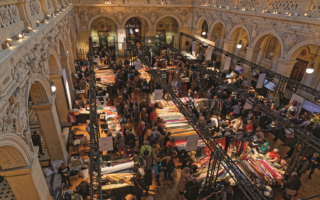An interview with Peter Mayle
The writer best-known for A Year in Provence and A Good Year talks to Zoë McIntyre about the French art de vivre and his life in the Luberon
What is your first memory of visiting France?
My first visit was to Paris long ago. I was 14 and I remember thinking that the city smelt foreign – strong black coffee, even stronger black tobacco, highly scented ladies, the whiff of subterranean life coming from the métro station; it was all very exotic and I loved it. I still do.
What makes your adopted home, the Luberon, so special?
For a start, it’s very beautiful. I prefer to look at mountains and forests rather than the sea, and the play of light on the Luberon, different each season, is a daily treat. Apart from July and August, even the well-known villages are calm. You can find talented people doing interesting things – making good wine and excellent goats’ cheese, cutting stone and forging ironwork, producing glorious honey, world-class olive oil and, naturally, baguettes that are made every day at 5am.
How did Ridley Scott’s film version of your book A Good Year come about?
I’ve known Ridley since we both worked in the advertising business and he has a house in Provence, not very far from ours. So we already had a lot in common when I told him that I was working on a story set in our neighbourhood. Spurred on, I’m sure, by the thought of spending the summer in his Provençal house filming this spectacular countryside, he asked me to show the story to him. Which I did, and I was delighted with what he did with it.
Why did you leave Provence for New York and why did you return?
We [he and his wife Jennie] went to New York partly to avoid the journalists skulking in our garden and partly to see more of my four children who live in America. Our time in the States was very pleasant, but it wasn’t Provence. So we crept back, moved house and picked up where we had left off. So far, I’m happy to say, the British press has found other fish to fry, and we’ve been left alone.
You’ve set recent books in Marseille. What do you make of the city?
Marseille suffers from its reputation as a rather sinister city – a reputation that it doesn’t deserve. Much of it is beautiful and I have always found the inhabitants to be friendly. It’s a place that takes some work getting to know, but that’s to be expected from a city that is more than 2,000 years old.
You write a lot about French gastronomy. What’s your perfect meal?
I would start with some politically incorrect foie gras. As a main course, I’d like a little cassoulet and the celebrated beans of Castelnaudary in Languedoc. After that, if I still have room, some fresh goat’s cheese drizzled with olive oil and accompanied by a dash of fig jam. Finally, a slice of fiadone, the excellent Corsican cheesecake made with brocciu cheese, lemon zest, sugar and eggs. That will do, until lunchtime tomorrow.
How do you find new inspiration for your books?
Quite a lot comes from watching and listening to people in bars and cafés. I also find the occasional flash of inspiration in La Provence, the local newspaper. Recently I was intrigued by a rash of multi-million-euro jewel robberies on the Riviera, which gave me the idea for the book I’m currently writing, The Diamond Caper.
What was it like to be made a Chevalier de la Légion d’Honneur?
It was absolutely terrific. I was immensely touched that the French had seen fit to honour a ‘sacré Anglais’ in such a way. I wear the little red ribbon in my buttonhole with great pride.
Share to: Facebook Twitter LinkedIn Email


